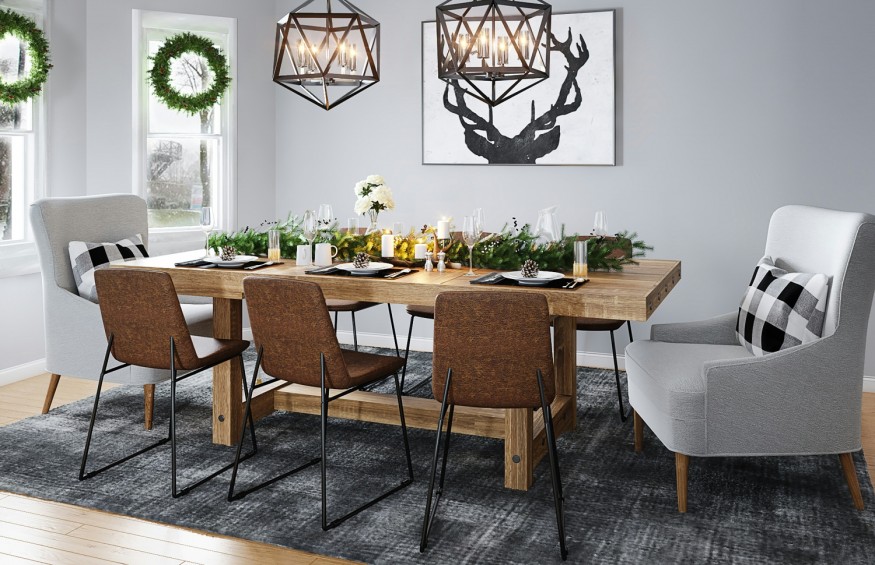10 Modern Dining Room Ideas To Elevate Your Gatherings

There's more to dining room design than simply positioning furniture, it is about creating an atmosphere that encourage communion, elicits conversation, and provides aesthetic backdrop to many togetherness. Whether the individual is redesigning an elegant dining room or adding a built-in dining area to an open, multi-functional living space, here are some tips on creating a chic and inviting dining space.
What Design Features Characterize a Modern Dining Room?
Technological sophistication is reduced to basic elements and identified with functional simplicity, geometric shapes, and balanced constructions. In a recent interview, Claire Paquin of Clean Design in Scarsdale, New York, writes that minimalism is a key ingredient in the definition of modern style. Part of the beauty of this style may arise from the absence of elaborateness. This is done by ensuring that the design is simple and has no attention-seeking features by introducing accessories and bright shades to accent the space.
Choose Your Lighting Fixture First:
Start by selecting a striking pendant light or chandelier to serve as the focal point of your dining space. Opt for sleek, minimalist designs that complement the overall modern aesthetic.
Create Contrast with Window Treatments:
Balance the clean lines of modern furniture with soft, textured window treatments. To add visual interest, consider floor-to-ceiling drapes or Roman shades in a contrasting color or pattern.
Create a Statement Wall:
Make a bold statement with a feature wall adorned with textured wallpaper, a vibrant paint color, or an eye-catching mural. This focal point adds depth and personality to the room.
Add a Bold Accent Color:
Inject a pop of color into your dining room with accent pieces such as chairs, artwork, or tableware. Opt for bold hues like emerald green, navy blue, or mustard yellow to create a dynamic focal point.
Try an Architectural Wall Covering:
Elevate your dining space with a textured wall covering, such as reclaimed wood paneling or geometric tiles. This adds visual interest and dimension to the room while maintaining a modern aesthetic.
Utilize Pattern Repetition:
Incorporate subtle patterns or motifs throughout the room to create a cohesive look. Consider repeating geometric shapes or graphic prints in textiles, artwork, or accessories.
Mix Old and New:
Blend vintage and contemporary elements to add character and charm to your dining room. Pair modern furniture with antique accents or heirloom pieces for a timeless yet eclectic vibe.
Embrace an Open Floor Plan:
If your dining area is part of an open floor plan, use furniture placement and area rugs to define the space while maintaining a sense of flow and cohesion with the surrounding areas.
Mix Different Finishes:
Mix different finishes and materials, such as metal, wood, and glass, to add visual interest and texture to your dining room. Opt for sleek, minimalist finishes for a cohesive, modern look.
Choose a Minimal Color Palette:
Use a few colors only and try to be consistent with your choice, preferably earth colors with flashes of bright, unrelated colors. Flickering light makes the interior refined and calm, which corresponds to the modern house concept.
Thus, using these tips for dining room design, people will be able to design a space, which besides producing only smiles and laughter when people are sitting around the table during dinner, will also be a perfect frame for mouth-watering food finished with envy-inducing desserts for their families and friends. Therefore, grab your chairs, bring out your recipe books, and prepare to entertain countless social affairs in your completely change-over dining area!
Related Article : Top 5 Ceiling Paint Colors for a Stylish Interior Transformation
From Digital Models to 3D-Printed Homes: Jaspreet Kaur Lall Explains How the Innovation Changes the Construction Industry

Future Belongs to Green Construction: Sampath Kumar Paspunoori Explains One of the Key Trends in the Construction Industry

Kamala Harris' Campaign Ad Uses Iconic Visuals from Carrie Mae Weems to Connect with Voters

Historic Ancient Roman Ruins in Baalbek Remain Strong After Israeli Air Strikes; Locals Seek Cultural Protection

4 Ways to Honor Departed Loved Ones in Your Home Design












